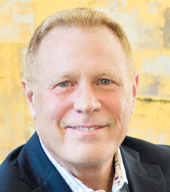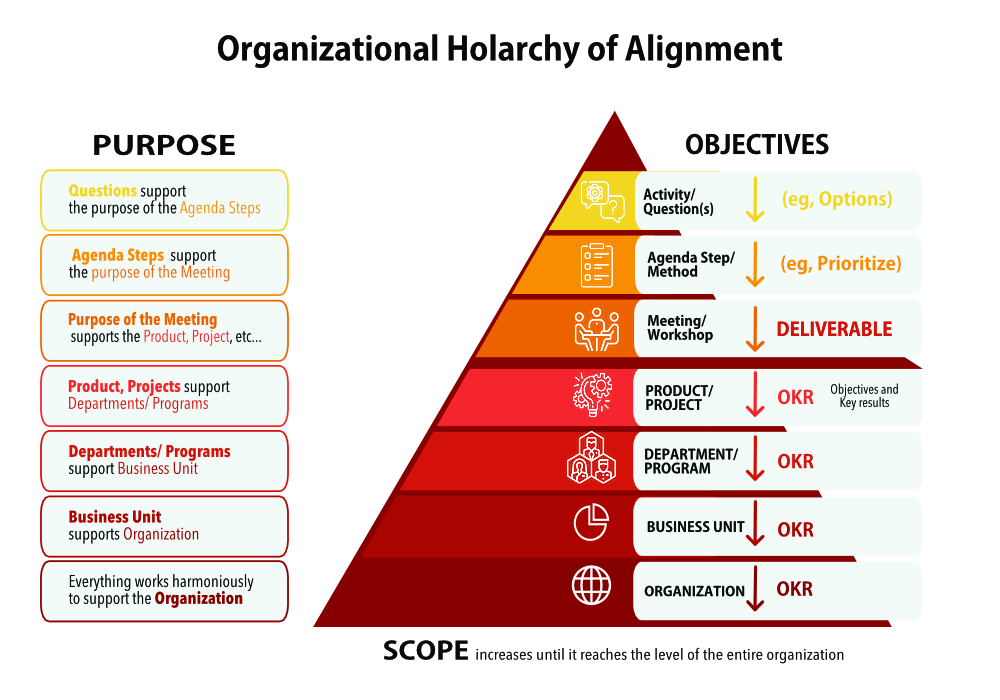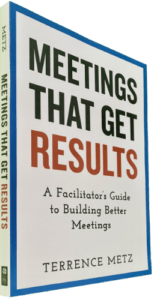The discipline of structured facilitation differs from what we respectfully refer to as “Kum Ba Yah” or “warm and fuzzy” facilitation which frequently begins by co-creating ground rules.
Most corporate environments simply do not afford enough time to follow the slow but sure path of building trust and camaraderie among participants. The holarchy provides a good reason why structured facilitation accelerates faster.
Enterprise Alignment
Typical meetings involve report-outs and updates such as staff meetings (typically, loosely structured). Structured facilitation supports workshops and non-staff meetings that occur when report-outs and updates are complete. Frequently structured facilitation supports a specific scope of work we refer to as a “project.” The difference between a project and the program it supports is the same difference one finds between a process and an activity. Both an activity and a project have a discrete starting and stopping time. Programs and processes, however, are typically ongoing or sustaining. We could calculate how much time you invest per year in the activity of “paying bills”. Yet, the process of “accounts payable” never stops.
Why is this important? When active listening fails to reconcile different viewpoints, structured facilitation through a disciplined facilitator takes the team back to the project objectives or the reason for the meeting in the first place. Next, we can view the program goals to improve consensual understanding as to why the project was approved. Finally, we can appeal to the business unit and/ or enterprise objectives to see which argument best supports or aligns with our primary objectives, mission, and vision.
Appealing to Objectives
Appealing to the objectives to reconcile arguments underlies structured facilitation that is missing from many Kum Bah Yah settings. Notice, for example, to stimulate peace in the Middle East, the structured facilitation approach suggests reconciling arguments first with active listening and then by appealing to the objectives in the holarchy, shown in the diagram below. However, when there are no SHARED purpose, scope, and objectives, there is no ultimate appeal for resolving arguments.
In corporate environments, all arguments are best answered by which position most strongly supports the corporate objectives. With Kum Bah Yah, the objectives may be competing. Therefore we rely on a different tool set, than pure decision-making science. Both structured facilitation and unstructured facilitation have their time and place but do not confuse one for the other. No corporate culture can invest two or three hours to build ground rules at the start of meetings and workshops. We do need a clear line of sight, however, to the project, program, business unit, and enterprise objectives that our meeting supports.
______
Don’t ruin your career by hosting bad meetings. Sign up for a workshop or send this to someone who should. MGRUSH workshops focus on meeting design and practice. Each person practices tools, methods, and activities every day during the week. Therefore, while some call this immersion, we call it the road to building high-value facilitation skills.
Our workshops also provide a superb way to earn up to 40 SEUs from the Scrum Alliance, 40 CDUs from IIBA, 40 Continuous Learning Points (CLPs) based on Federal Acquisition Certification Continuous Professional Learning Requirements using Training and Education activities, 40 Professional Development Units (PDUs) from SAVE International, as well as 4.0 CEUs for other professions. (See workshop and Reference Manual descriptions for details.)
Want a free 10-minute break timer? Sign up for our once-monthly newsletter HERE and receive a timer along with four other of our favorite facilitation tools, free.

Terrence Metz, president of MG RUSH Facilitation Training, was just 22-years-old and working as a Sales Engineer at Honeywell when he recognized a widespread problem—most meetings were ineffective and poorly led, wasting both time and company resources. However, he also observed meetings that worked. What set them apart? A well-prepared leader who structured the session to ensure participants contributed meaningfully and achieved clear outcomes.
Throughout his career, Metz, who earned an MBA from Kellogg (Northwestern University) experienced and also trained in various facilitation techniques. In 2004, he purchased MG RUSH where he shifted his focus toward improving established meeting designs and building a curriculum that would teach others how to lead, facilitate, and structure meetings that drive results. His expertise in training world-class facilitators led to the 2020 publication of Meetings That Get Results: A Guide to Building Better Meetings, a comprehensive resource on effectively building consensus.
Grounded in the principle that “nobody is smarter than everybody,” the book details the why, what, and how of building consensus when making decisions, planning, and solving problems. Along with a Participant’s Guide and supplemental workshops, it supports learning from foundational awareness to professional certification.
Metz’s first book, Change or Die: A Business Process Improvement Manual, tackled the challenges of process optimization. His upcoming book, Catalyst: Facilitating Innovation, focuses on meetings and workshops that don’t simply end when time runs out but conclude with actionable next steps and clear assignments—ensuring progress beyond discussions and ideas.




